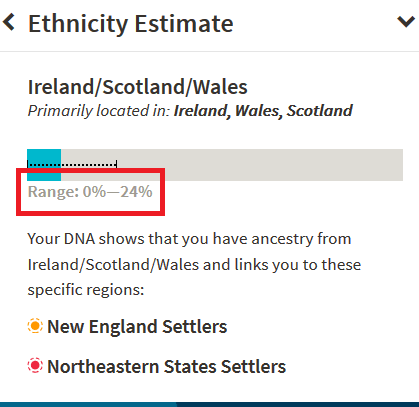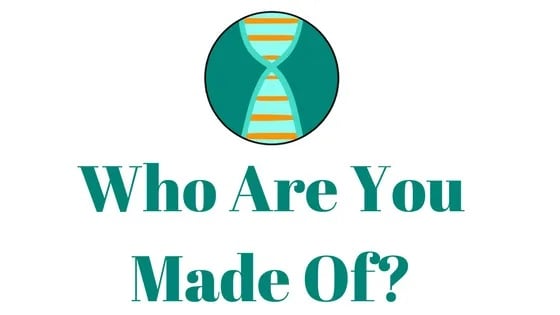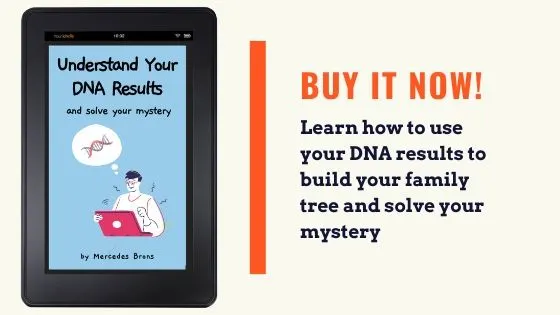Ethnicity estimates are the source of a lot of confusion and discussion in the genetic genealogy world. One very common question that people have is whether a child can have more of an ethnicity than a parent does.
It is understandably confusing when this happens. In this post, I will help you understand a few reasons why this can happen, and what it really means.
This post will address a few different situations and give a few possible explanations for each:
- When neither of your parents have tested, but you know their ancestry, why is your ethnicity showing something that they didn't have?
- When one of your parents has tested with a different company, and your ethnicity estimate shows something different than theirs
- When both of your parents have tested with the same company, yet your results show more of an ethnicity that you could have inherited from either of your parents
Neither of my parents have tested, but I know their ancestry - why does my ethnicity estimate show this ethnicity?
Sometimes, when people find surprises in their DNA ethnicity results, their mind immediate wanders to the obvious: have they uncovered a secret? Maybe one of their parents wasn't really their parent? Maybe one of their parents was adopted?
The thought process is understandable.
While these scenarios are definitely possible (as they say, there is nothing new under the sun!), an ethnicity result can never, ever be "proof" of such an occurrence.
Since you haven't tested, or can't test, your parents' DNA, you will have to have an open mind when looking at your results. There are many other reasons why your ethnicity estimate can be different than what you would expect.
Your parents could have had ancestry that you didn't know about
It's possible that your parents really do have extensive roots in a certain part of the world, but they had DNA from many distant ancestors from a nearby region. For example, people in Germany can often have a lot of Eastern European DNA.
When you combine this with the fact that most companies don't/can't test for a "German" ethnicity, it can add to the difficult in making sense of your results. German usually shows up as "Europe West" or "Western European", though Germans can also have any number of other ethnicities from nearby regions - so this might be what is happening in your case.
The expected ethnicity region might be included in another region on your DNA results
It's difficult for the DNA testing companies to "isolate" DNA from certain parts of the world. If you have any ancestry that includes the indigenous citizens of North and South America, you might find a very vague "Native American" on your ethnicity,which might confuse folks with ancestors from Argentina, Brazil, or Mexico.
Ancestry DNA does offer more than two dozen more specific categories under the general Native American category, but it only really helps if you have very recent ancestors with indigenous American roots.
Your ethnicity estimate might reveal surprises about your parents' ancestry
It's possible that what you were told, or have learned about your family tree is incorrect. Especially when you see an ethnicity that is completely unexpected - like from a different continent - than what you thought you would find, and especially when it is a relatively high percentage.
When this happens, it's worth looking into more thoroughly. For example, I know a young lady whose father is from Mexico and mother is American. Her mother only has just a few percentage of Irish ethnicity, but the young lady has 12% Irish.
This very obviously means that her father had Irish DNA, even though most people believe (incorrectly) that someone from Mexico will only have Iberian and Native American DNA.
Of course, the best course of action is to have one or both of your parents do a DNA test, if you can. If they aren't interested, or aren't available for testing, you can get a better idea of what their ethnicities might have been by having as many siblings do a test.
If you have an aunt or uncle on either side, or on both sides, that can also help you learn about your parents' ancestry. Siblings, even if they are 100% full siblings, won't have identical DNA, and their ethnicity results might look very different - but their results are still helpful, since their ancestry is your ancestry, no matter what it shows.
My parents (or parent) tested with a different company and their ethnicity results don't match mine
If your parents did a DNA test with another company and you show more of an ethnicity than what they have on their results, there are three simple explanations that are the most likely.
- The DNA testing companies all use different reference populations to compare against your DNA to get your ethnicity estimate. Every reference population is slightly different, so it could just be that their reference population is different enough than that of the other company, leading to different results on all of your ethnicity results.
- Sometimes, testing companies use different vocabulary to describe similar geographic regions. For example, My Heritage reports indigenous Mexican DNA as "Central America", and Ancestry reports it as "Native American" and might also attach it to a subcategory.
- Other times, DNA testing companies "group" regions together differently. For example, some companies test for "Great Britain/Wales/Scotland" and other companies put Scotland and Ireland together, and Great Britain by itself.
If both of your parents tested with another company, I do have a few suggestions as to how you can get a more uniform ethnicity estimate for the three of you together:
- Upload all three of your DNA files to My Heritage DNA
- Upload all three of your DNA files to Family Tree DNA
- Upload all three of your DNA files to Gedmatch and/or Gedmatch Genesis
(You can do these suggestions even if you don't have any questions, as you can learn a lot from DNA matches at other sites!)
What if both of my parents tested at the same company and I still show an ethnicity that they don't have, or higher percentage than they do?
The answer to this question is fairly simple. When your testing company provides you with your ethnicity estimate, there is a range of percentages for each ethnicity that they say you have.
Some DNA testing companies provide you with the range, and others don't - but you should still know that there likely is a range. For example, take a peek at the range that Ancestry DNA provides:

The above image is from my own DNA results. On my estimate, it says I have 9% Irish DNA, but if I click on it, it tells me that my range of Irish DNA is actually very wide.
I could have a little as 0% to as high as 24%. The only way I could know for sure if I am Irish would be to trace my family tree, which I have (and I am Irish, yay!).
I should stress again that even if your company doesn't provide you with a range, there is a range.
The lesson here is that our ethnicity estimate is only an estimate based on a range. If yours doesn't match up with your parents on a specific ethnicity, it could just be the "range effect", as I like to call it.
An additional comment that I have on this specific topic is that if you show a very small percentage, like 1-2% of a particular ethnicity, and neither of your parents have it, there are two things that could have happened:
- It is within the range of a "trace" ethnicity and could be what some people like to call "statistical noise"
- Your parents could have had a very small percentage, too small to show up on their results, but you happened to inherit all of it from both of them - adding up to a detectable percentage on your results.
Conclusion
I hope that this post gave you some ideas as to how you might have an ethnicity that your parents don't have, or a higher percentage of an ethnicity than they do.
If you have any questions, comments, or just want to share your own personal experience, please feel free to leave me a comment below.
Thanks for stopping by!


Kenneth Cox
Monday 13th of January 2025
Can a child have different ethnicity than either parent? ( All tested by Ancestry DNA) Does this look possible?
Father Mother Daughter England & Northwestern Europe 46% 50% 66.8% Germanic Europe 18% 36% 0% Scotland 18% 8% 0% Ireland 10% 0% 0% Denmark 5% 2% 0% Cornwall 2% 0% 0% Norway 1% 0% 0% The Netherlands 0% 2% 0% Spain 0% 2% 0% Scandinavian 0% 0% 23.5% Greek and South Italian 0% 0% 5% Balkan 0% 0% 3.1% Ashkenazi Jewish 0% 0% 1.6%
Yasmin
Monday 26th of February 2024
My mother and I both had DNA tests done with the same company, mine came back as 8.2% English while hers came back 93% English. How is this possible? My father was North African, and I came back as 48.4% North African. Then there's a 28.2 % Iberian that I can't account for because there is no Iberian on my mother's side. I have to say, it leaves me questioning the validity of these tests.
Laurie
Saturday 4th of March 2023
Hi, after years of research it is clear that my father’s ancestry is only Irish, English, Scottish, Welsh, German band maybe a little Polish or other East European. On my mother’s side, her mother’s family was Norwegian with a small sprinkling of German. Her father’s family was Swedish, with a portion of Belgian (Walloons who migrated to Sweden in the 18th century). On both 23 and me and ancestry.com my DNA results come back with over 50% Swedish/Danish, maybe 8% Norwegian and the rest mostly English. How is it possible that I can be more Swedish than my mother and have so little of my father’s ethnicity? Both parents are deceased so I cannot ask them to be tested. My brother’s results came out in almost perfect proportion to the known backgrounds of our ancestors. Do U have a severe case or uniparental disomy, or what? I’m kind of concerned as I have kids and would want to know how it could affect them. Thanks!
Maddy Davies
Wednesday 20th of October 2021
Thank you for this, We was wondering how our son has 3.6% Iberian & 3.6% Italian but neither me or his father does but he is 1million per cent our son. Now it makes sense
Ken Baugh
Wednesday 9th of June 2021
My original test was with 23and me. Result- Basically 100% British/NW European When I transferred it to MyHeritage (and did a second sample to) I came back 79% British,14%East European and 7% west ASIAN! I couldnt believe this and had my 2 sisters tested-result?virtually 100% British/NW European I have had a new test with Ancestry for me -result virtually 100% British/NW European.
I just CANNOT believe MyHeritage's analysis of my result is correct. West Asian heritage cannot be confused with European can it? Not to mention 14% EAST EUROPEAN. They won't hear of it!!
As a result of this I have to say I have NO faith in ethnicity reports from DNA.They are not derived from the same sources as family relationships are. There is too much estimation and averaging going on, not to mention the intervention of different methods of analysing employed by the different companies' chips